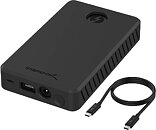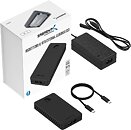Tuesday, June 22nd 2021
Sabrent Launches Massive 16 TB Variant of XTRM-Q Thunderbolt+USB3 External SSD
Sabrent on Monday launched a massive 16 TB variant of its XTRM-Q external SSD that debuted last year in capacities of up to 8 TB. The 16 TB XTRM-Q encloses two 8 TB SSD subunits. Out of the box, these are striped to create the 16 TB volume, but you can re-configure these to run in RAID 1, for data redundancy, or even JBOD/sequential.
What makes the Sabrent XTRM-Q stand out is its Thunderbolt 3 + USB 3.2 dual-mode operation. Unlike the single-drive based XTRM-Q 8 TB, the 16 TB version features a larger body, and requires external power through an included power brick, in addition to the Thunderbolt/USB connection. In striped mode, the driver offers sequential transfer rates of up to 2500 MB/s in Thunderbolt mode. The enclosure is made of aluminium, and doubles up as a heatspreader for the drives underneath. The enclosure is covered by a removable silicone outer sheath. Without this, the drive measures 114.3 mm x 65 mm x 17.2 mm (LxWxH). Available now, it is priced at USD $2,899.
What makes the Sabrent XTRM-Q stand out is its Thunderbolt 3 + USB 3.2 dual-mode operation. Unlike the single-drive based XTRM-Q 8 TB, the 16 TB version features a larger body, and requires external power through an included power brick, in addition to the Thunderbolt/USB connection. In striped mode, the driver offers sequential transfer rates of up to 2500 MB/s in Thunderbolt mode. The enclosure is made of aluminium, and doubles up as a heatspreader for the drives underneath. The enclosure is covered by a removable silicone outer sheath. Without this, the drive measures 114.3 mm x 65 mm x 17.2 mm (LxWxH). Available now, it is priced at USD $2,899.


17 Comments on Sabrent Launches Massive 16 TB Variant of XTRM-Q Thunderbolt+USB3 External SSD
What's even the point of it being thunderbolt if it's limited to 20gbps? Or is it TB2?
And FYI, they also said they were slow as crap then, and apparently still are, hehehe :)
Bottom line is it's not fast enough to warrant being TB3 and that cost certainly gets passed onto the consumer, and Sabrent probably uses the excuse of it being TB3 to add some extra margin. It's lying and directly anti-consumer.
It doesn't warrant being TB3 with that speed, all that does is make people believe it's high end (cuz thunderbolt gud) to increase prices. It's slower than single entry-level QLC drives, never mind the fact that it's supposedly striped so there's two drives in there. I'd expect it to saturate the TB3 40Gbps spec easily but it caps out at 20Gbps which makes no sense if it's NVMe. It must be artifically limited somewhere, the drives have to be faster than that. As I said, even the slowest single NVMe drive is still faster than these TWO STRIPED drives. If they were SATA based it's too fast (two striped SATA drives would cap out at around 1GB/s, not 2,5GB/s), so it must be NVMe, but the rated speed just makes no sense.
And if it IS TB3 and the limit is really in the drives or controller; why advertise it being TB3 or implement the required hardware for it to be TB3 if it can't reach it? It just ups the cost for zero reason...
This is like advertising HDMI 2.1 on a 1080p 60Hz monitor...
These are not NVMe drives, they are external drives that can be taken anywhere with a power supply to a outlet.
I don't see why splitting the lanes would make it slower than a single drive, you'll have to explain a bit further on that.
Plenty lower-end motherboards also restrict certain M.2 slots to x2 and striping those together would still end up being faster than a single drive.Still sticking to it, huh?
Just because I don't have the engineering expertise to actually fundamentally design a solution to a product like this - that doesn't necessarily mean I lack the knowledge on when the end product they do provide is bad. What I do know is that the interface could be 3.2 Gen 1 and they would lose no bandwidth and reduce costs quite a lot, and open up to the much larger market that only has USB instead of Thunderbolt.
The drives have to be adressed by some protocol, so they're either SATA or NVMe. All drives have to be adressed by some storage protocol. Just because they're external, that doesn't mean they don't get adressed in their protocols. Practically every external drive that exists is just a USB to SATA controller adapter, the rest are USB/TB to NVMe.
SATA is ruled out simply by speed - a striped pair of SATA drives cap out at 1GB/s; too slow to ever possibly be this solution. That leaves NVMe as the only possible protocol, and it being TB3 with its 4 lanes of bandwidth backs that up.
Either these are the worst NVMe drives ever created, or whatever controller they're using is ultra-garbage and leaves 50% of the performance on the table due to overhead. That really is the only thing I can think of that would make these perform that bad.
-It's a given that a striped layout over TB will be significantly slower than a striped layout over direct PCIe (whether CPU or chipset) due to latency
-Striping across inherently slow QLC drives might not be as efficient
-There's no guarantee that these drives have the same SLC caching behaviour as desktop drives
-It's likely the firmwares of these drives are tuned differently than desktop drives, which are often tuned towards (utterly meaningless) drag-race sequential transfer metrics. These SSDs are most likely tuned to avoid excessive thermal loads and to be better suited for external drive use cases.
Etc., etc.
Not all storage devices have to be address with SATA or nvme connection. Some times, a company will make their own propriety connector. I cant think of the company's name, but years ago, maybe over 6-7 years, I shucked a external HD. I checked the connector and it wasnt SATA. I returned it to the store, bought another brand.
It might be at the device has so many NAND on the PCB board it requires extra juice.
Also, it can't be that dense as there's a thermal limit as well. NVMe drives can't really draw more than 10-12W before they physically can't be cooled down properly anymore on the M.2 form factor, which given the size of this external enclosure, they are 100%, or at least a similar size. So thermally they're really limited to about 10-12W per drive, so about a 25W budget for both.